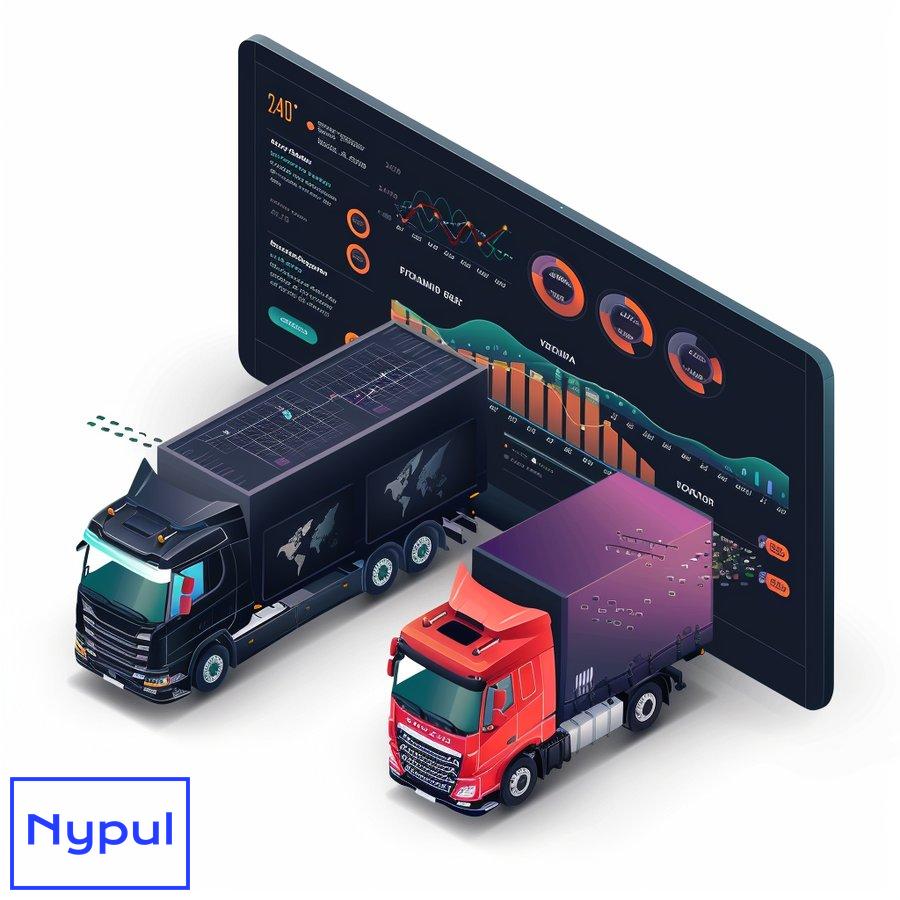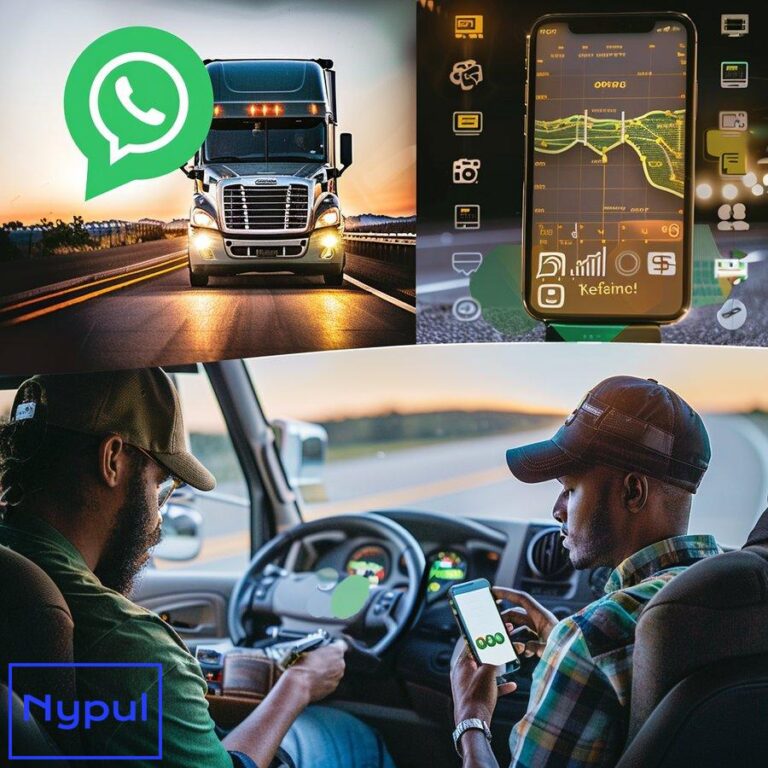What Is Geofencing in Trucking
Geofencing in trucking is a location-based technology that creates virtual boundaries around specific geographic areas. These virtual perimeters, known as geofences, can be customized to any shape or size, from a small parking lot to an entire city or state. When a truck equipped with GPS tracking enters or exits these predefined zones, the system triggers real-time alerts or automated actions.
This innovative technology combines Global Positioning System (GPS) data, Radio Frequency Identification (RFID), cellular data, and Wi-Fi or Bluetooth beacons to establish and monitor these virtual boundaries. Geofencing allows trucking companies to track their fleet’s movements with unprecedented precision, enabling them to optimize routes, enhance security, and improve overall operational efficiency.
Key Components of Geofencing Systems
GPS Tracking Devices: These are installed in trucks to continuously transmit location data.
Geofence Software: This software defines the virtual boundaries and processes the location data from GPS devices.
Communication Network: This network transmits data between trucks and the central management system.
Central Management System: This system receives and analyzes data, generating alerts and reports based on predefined rules.
Geofencing in trucking goes beyond simple location tracking. It provides a dynamic tool for fleet managers to monitor and control various aspects of their operations. For instance, geofences can be set up around customer locations, warehouses, or high-risk areas. When a truck enters or leaves these zones, the system can automatically notify relevant parties, update delivery status, or flag potential security concerns.
The versatility of geofencing technology allows for its application in numerous scenarios within the trucking industry. From ensuring drivers adhere to designated routes to automating time-tracking at job sites, geofencing offers a wide range of possibilities to enhance fleet management and logistics operations.
How Does Geofencing Work?
Geofencing in trucking operates on a simple yet powerful principle: it combines location data with predefined geographic boundaries to trigger specific actions or alerts. The process involves several key steps and components working in tandem to create an effective geofencing system.
Step 1: Defining the Geofence
The first step in implementing geofencing is to define the virtual boundaries. Fleet managers use specialized software to draw these boundaries on digital maps. These geofences can be circular, polygonal, or follow specific routes. The size and shape of the geofence depend on its intended purpose. For example, a geofence around a warehouse might be a simple circle with a radius of a few hundred meters, while a geofence for a delivery route might follow a complex path across multiple states.
Step 2: GPS Tracking
Each truck in the fleet is equipped with a GPS tracking device. These devices continuously determine the truck’s location using signals from GPS satellites. The frequency of location updates can vary depending on the system’s requirements, but many modern systems provide real-time or near-real-time tracking.
Step 3: Data Transmission
The GPS device transmits the location data to the central management system. This transmission typically occurs over cellular networks, allowing for real-time communication even when trucks are on the move. In areas with poor cellular coverage, some systems can store data locally and transmit it when a connection becomes available.
Step 4: Data Processing
The central management system receives the location data and compares it to the predefined geofences. This comparison happens continuously as new location data comes in. The system checks whether the truck’s coordinates fall within any of the established geofences.
Step 5: Triggering Actions
When a truck crosses a geofence boundary (either entering or exiting), the system recognizes this event and triggers predetermined actions. These actions can include:
Sending Alerts: Notifications can be sent to fleet managers, drivers, or customers via email, SMS, or in-app notifications.
Updating Status: The system can automatically update the status of a delivery or job in the company’s management software.
Logging Data: The entry or exit event can be recorded for later analysis or reporting.
Activating or Deactivating Features: Certain vehicle features or policies might be automatically enabled or disabled based on the truck’s location.
Here’s a table summarizing the key components and their roles in a geofencing system:
| Component | Role |
|---|---|
| GPS Device | Determines truck’s location |
| Geofence Software | Defines virtual boundaries |
| Cellular Network | Transmits location data |
| Central Management System | Processes data and triggers actions |
| Alert System | Notifies relevant parties of geofence events |
The effectiveness of geofencing relies on the accuracy of GPS technology and the reliability of data transmission. Modern GPS systems can provide location accuracy within a few meters, making geofencing a highly precise tool for fleet management. However, factors such as urban canyons (areas surrounded by tall buildings) or remote locations with poor satellite visibility can affect GPS accuracy.
Geofencing systems often incorporate additional technologies to enhance their capabilities. For instance, some systems use RFID tags or Bluetooth beacons for more precise location tracking in areas where GPS signals might be unreliable, such as inside warehouses or in dense urban environments.
The flexibility of geofencing allows for dynamic adjustments to meet changing business needs. Geofences can be easily modified, added, or removed as required. This adaptability makes geofencing a powerful tool for trucking companies dealing with evolving routes, temporary job sites, or seasonal changes in operations.
What Are the Benefits of Geofencing for Trucking Companies?

Geofencing technology offers numerous advantages for trucking companies, revolutionizing fleet management and logistics operations. These benefits span various aspects of the business, from operational efficiency to customer satisfaction. Let’s explore the key advantages that make geofencing an invaluable tool for modern trucking companies.
Enhanced Operational Efficiency
Geofencing significantly improves operational efficiency by providing real-time visibility into fleet movements. This enhanced visibility allows for better resource allocation and route optimization. Fleet managers can identify inefficiencies, such as unnecessary idling or deviations from planned routes, and take corrective actions promptly.
Automated Time and Attendance Tracking: Geofencing eliminates the need for manual time-tracking at job sites. The system can automatically record when a truck enters or leaves a designated area, providing accurate data for payroll and job costing.
Streamlined Dispatching: With geofencing, dispatchers can easily identify the nearest available truck for a new job, reducing response times and improving customer service.
Improved Safety and Security
Geofencing plays a crucial role in enhancing the safety and security of both drivers and cargo.
Route Compliance: Geofencing ensures drivers stick to approved routes, reducing the risk of accidents or theft in high-risk areas.
Theft Prevention: If a truck deviates from its designated route or enters an unauthorized area, immediate alerts allow for quick response to potential theft situations.
Driver Safety Monitoring: Geofences can be set up to monitor driver behavior in specific areas, such as reducing speed in school zones or residential areas.
Enhanced Customer Service
Geofencing technology enables trucking companies to provide superior customer service through improved communication and transparency.
Accurate ETAs: Real-time location data allows for more precise estimated times of arrival, which can be automatically communicated to customers.
Proactive Updates: Geofencing can trigger automated notifications to customers when a truck is approaching their location, reducing wait times and improving the overall delivery experience.
Proof of Service: Geofencing provides verifiable data on when trucks arrived at and departed from customer locations, helping to resolve disputes and improve accountability.
Regulatory Compliance
Geofencing assists trucking companies in adhering to various regulatory requirements.
Hours of Service (HOS) Compliance: Geofencing can automatically track driving time and rest periods, ensuring compliance with HOS regulations.
Electronic Logging Device (ELD) Integration: Geofencing data can be integrated with ELD systems to provide accurate, automated records of driver activities.
Environmental Compliance: Geofences can be used to enforce idle-reduction policies in specific areas, helping companies meet environmental regulations.
Cost Reduction
The implementation of geofencing can lead to significant cost savings for trucking companies.
Fuel Savings: By optimizing routes and reducing unauthorized use of vehicles, geofencing helps decrease fuel consumption.
Reduced Labor Costs: Automated time-tracking and improved dispatching efficiency can lead to reduced overtime and more effective use of driver hours.
Lower Insurance Premiums: The enhanced security and safety features of geofencing can potentially lead to reduced insurance costs.
Data-Driven Decision Making
Geofencing provides a wealth of data that can be used to inform strategic decisions.
Performance Analytics: Data on route efficiency, delivery times, and driver behavior can be analyzed to identify areas for improvement.
Resource Allocation: Historical geofencing data can help in planning optimal fleet sizes and distribution of resources across different regions.
Customer Insights: Geofencing data can provide valuable insights into customer patterns and preferences, informing business development strategies.
Here’s a table summarizing the key benefits of geofencing for trucking companies:
| Benefit Category | Specific Advantages |
|---|---|
| Operational Efficiency | Automated time tracking, Streamlined dispatching, Route optimization |
| Safety and Security | Route compliance, Theft prevention, Driver safety monitoring |
| Customer Service | Accurate ETAs, Proactive updates, Proof of service |
| Regulatory Compliance | HOS compliance, ELD integration, Environmental regulation adherence |
| Cost Reduction | Fuel savings, Reduced labor costs, Potential insurance savings |
| Data-Driven Decisions | Performance analytics, Resource allocation insights, Customer behavior analysis |
The benefits of geofencing extend beyond these categories, as the technology continues to evolve and find new applications in the trucking industry. As companies become more adept at leveraging geofencing data, they can uncover additional advantages and competitive edges in the market.
Implementing geofencing requires an initial investment in technology and training, but the long-term benefits often far outweigh the costs. As the trucking industry faces increasing pressure to improve efficiency, safety, and customer service, geofencing emerges as a critical tool for companies looking to stay competitive in a rapidly evolving market.
What Are the Key Applications of Geofencing in Logistics?

Geofencing technology has found numerous applications in the logistics industry, revolutionizing how trucking companies manage their operations. These applications span various aspects of logistics, from fleet management to customer service. Let’s explore the key ways in which geofencing is being utilized in the logistics sector.
Fleet Management and Tracking
Geofencing plays a crucial role in modern fleet management systems, providing real-time visibility and control over vehicle movements.
Real-Time Vehicle Tracking: Geofencing allows logistics companies to monitor the exact location of their vehicles at all times. This real-time tracking enables better coordination and quick response to any issues that may arise during transit.
Route Optimization: By analyzing historical geofencing data, companies can identify the most efficient routes for their trucks. This optimization leads to reduced fuel consumption and faster delivery times.
Vehicle Utilization Monitoring: Geofencing helps track how long vehicles spend at various locations, such as loading docks or customer sites. This information can be used to improve vehicle utilization and reduce idle time.
Yard Management
Geofencing technology has transformed yard management in logistics operations.
Automated Check-In/Check-Out: When trucks enter or exit a yard, geofencing can automatically record their arrival or departure times, streamlining the check-in/check-out process.
Asset Tracking: Geofencing helps locate trailers and other assets within large yards, reducing the time spent searching for equipment.
Capacity Management: By monitoring the number of vehicles in a yard at any given time, companies can better manage yard capacity and plan for incoming shipments.
Delivery Management
Geofencing enhances the delivery process, improving efficiency and customer satisfaction.
Automated Notifications: When a truck enters a geofence around a delivery location, the system can automatically notify the customer of the impending arrival.
Proof of Delivery: Geofencing provides timestamped evidence of when a truck arrived at and departed from a delivery location, helping to resolve any disputes about delivery times.
Last-Mile Optimization: For urban deliveries, geofencing can help drivers navigate complex city environments more efficiently, reducing delays in the crucial last mile of delivery.
Driver Management and Safety
Geofencing applications extend to driver management, promoting safety and compliance.
Hours of Service (HOS) Compliance: Geofences can be set up around rest areas or truck stops to automatically log when drivers take required breaks, ensuring compliance with HOS regulations.
Speed Monitoring: Geofences can be established in areas with specific speed limits, alerting managers if drivers exceed these limits.
Route Adherence: Geofencing ensures drivers stick to prescribed routes, avoiding unsafe areas or roads unsuitable for large vehicles.
Security and Theft Prevention
Geofencing serves as a powerful tool for enhancing security in logistics operations.
Cargo Theft Prevention: If a truck deviates from its designated route or enters a high-risk area, geofencing can trigger immediate alerts, allowing for quick response to potential theft situations.
Unauthorized Use Detection: Geofencing can detect if vehicles are being used outside of authorized hours or areas, preventing misuse of company assets.
Secure Area Monitoring: For sensitive locations like warehouses or distribution centers, geofencing can monitor and control vehicle access, enhancing overall security.
Customer Service Enhancement
Geofencing technology significantly improves customer service in logistics.
Accurate ETA Predictions: By tracking vehicles in real-time, companies can provide customers with more accurate estimated times of arrival.
Proactive Issue Resolution: Geofencing alerts can notify customer service teams of potential delays or issues, allowing them to proactively communicate with customers and resolve problems.
Service Verification: Geofencing data provides concrete evidence of service delivery, helping to resolve any customer disputes quickly and efficiently.
Environmental Compliance
Geofencing assists in meeting environmental regulations and reducing the carbon footprint of logistics operations.
Idle Time Reduction: Geofences can be set up in areas where idling is restricted, alerting drivers or automatically shutting off engines to reduce emissions.
Green Zone Compliance: In cities with low emission zones, geofencing can ensure trucks comply with specific environmental regulations in designated areas.
Fuel Efficiency Monitoring: By tracking routes and speeds within specific geofences, companies can identify opportunities to improve fuel efficiency and reduce emissions.
Here’s a table summarizing the key applications of geofencing in logistics:
| Application Area | Specific Uses |
|---|---|
| Fleet Management | Real-time tracking, Route optimization, Vehicle utilization monitoring |
| Yard Management | Automated check-in/out, Asset tracking, Capacity management |
| Delivery Management | Automated notifications, Proof of delivery, Last-mile optimization |
| Driver Management | HOS compliance, Speed monitoring, Route adherence |
| Security | Cargo theft prevention, Unauthorized use detection, Secure area monitoring |
| Customer Service | Accurate ETA predictions, Proactive issue resolution, Service verification |
| Environmental Compliance | Idle time reduction, Green zone compliance, Fuel efficiency monitoring |
These applications demonstrate the versatility and power of geofencing in addressing various challenges in the logistics industry. As technology continues to evolve, we can expect to see even more innovative uses of geofencing in logistics, further enhancing efficiency, safety, and customer satisfaction.
The key to maximizing the benefits of geofencing lies in its integration with other logistics technologies and systems. When combined with telematics, artificial intelligence, and advanced analytics, geofencing can provide even deeper insights and more sophisticated automation capabilities. This integration is paving the way for the next generation of smart, efficient, and responsive logistics operations.
How Can Geofencing Improve Cross-Border Shipping?

Cross-border shipping presents unique challenges for logistics companies, including complex customs procedures, varying regulations, and potential security risks. Geofencing technology offers innovative solutions to many of these challenges, streamlining cross-border operations and enhancing overall efficiency. Let’s explore how geofencing can significantly improve various aspects of cross-border shipping.
Customs and Border Crossing Management
Geofencing plays a crucial role in managing the complexities of customs and border crossings.
Automated Documentation Preparation: As a truck approaches a border crossing, geofencing can trigger the automatic preparation and submission of necessary customs documentation. This proactive approach reduces waiting times at borders and ensures all required paperwork is ready in advance.
Real-Time Status Updates: Geofencing provides real-time updates on a truck’s position relative to border crossings. This information allows customs brokers and logistics managers to prepare for upcoming crossings and address any potential issues proactively.
Compliance with Customs Regulations: Geofencing can ensure trucks follow designated routes to customs checkpoints, helping companies comply with specific customs regulations that may require vehicles to use certain border crossings or follow particular routes.
Security Enhancement
Cross-border shipping often involves heightened security concerns, which geofencing can help address.
Route Deviation Alerts: If a truck deviates from its## How Can Geofencing Improve Cross-Border Shipping?
Cross-border shipping presents unique challenges for logistics companies, including complex customs procedures, varying regulations, and potential security risks. Geofencing technology offers innovative solutions to many of these challenges, streamlining cross-border operations and enhancing overall efficiency. Let’s explore how geofencing can significantly improve various aspects of cross-border shipping.
Customs and Border Crossing Management
Geofencing plays a crucial role in managing the complexities of customs and border crossings.
Automated Documentation Preparation: As a truck approaches a border crossing, geofencing can trigger the automatic preparation and submission of necessary customs documentation. This proactive approach reduces waiting times at borders and ensures all required paperwork is ready in advance.
Real-Time Status Updates: Geofencing provides real-time updates on a truck’s position relative to border crossings. This information allows customs brokers and logistics managers to prepare for upcoming crossings and address any potential issues proactively.
Compliance with Customs Regulations: Geofencing can ensure trucks follow designated routes to customs checkpoints, helping companies comply with specific customs regulations that may require vehicles to use certain border crossings or follow particular routes.
Security Enhancement
Cross-border shipping often involves heightened security concerns, which geofencing can help address.
Route Deviation Alerts: If a truck deviates from its designated route or enters an unauthorized area near a border, geofencing can trigger immediate alerts, allowing for quick response to potential security threats or smuggling attempts.
Secure Parking Monitoring: Geofences can be set up around secure parking areas near borders, monitoring vehicle movements and ensuring trucks stay within designated zones while awaiting customs clearance.
Cargo Integrity Verification: By combining geofencing with other technologies like RFID seals or trailer tracking devices, companies can verify the integrity of cargo throughout the cross-border journey, reducing the risk of tampering or theft.
Regulatory Compliance
Geofencing assists logistics companies in adhering to various regulations specific to cross-border shipping.
Hazardous Materials Monitoring: For trucks carrying hazardous materials, geofencing can ensure compliance with regulations by monitoring routes, speeds, and parking locations near borders.
Driver Hours of Service (HOS) Compliance: Geofences can track driver hours and rest periods, helping companies comply with HOS regulations that may vary across borders.
Customs Clearance Optimization
Geofencing can significantly optimize the customs clearance process, reducing delays and improving efficiency.
Automated Appointment Scheduling: As a truck approaches a border, geofencing can automatically schedule a customs clearance appointment based on factors like the truck’s location, cargo type, and available customs resources.
Dynamic Lane Assignment: Geofencing data can be used to analyze traffic patterns and assign trucks to the most appropriate customs lanes, minimizing wait times and congestion.
Customs Broker Coordination: Geofencing alerts can notify customs brokers of upcoming clearances, allowing them to prepare and be on-site when trucks arrive, further reducing delays.
Improved Customer Communication
Geofencing enhances communication with customers in cross-border shipping, providing transparency and building trust.
Accurate ETAs: By tracking trucks in real-time, geofencing enables more precise estimated times of arrival at final destinations, allowing customers to better plan for incoming shipments.
Proactive Notifications: Geofencing can automatically notify customers when a truck crosses a border or reaches a specific milestone in the journey, keeping them informed of the shipment’s progress.
Proof of Delivery: Geofencing provides timestamped evidence of when a truck arrived at and departed from a customer’s location, helping to resolve any disputes about delivery times or conditions.
Here’s a table summarizing the key ways geofencing can improve cross-border shipping:
| Improvement Area | Specific Benefits |
|---|---|
| Customs and Border Crossing Management | Automated documentation preparation, Real-time status updates, Compliance with customs regulations |
| Security Enhancement | Route deviation alerts, Secure parking monitoring, Cargo integrity verification |
| Regulatory Compliance | Hazardous materials monitoring, Driver HOS compliance |
| Customs Clearance Optimization | Automated appointment scheduling, Dynamic lane assignment, Customs broker coordination |
| Improved Customer Communication | Accurate ETAs, Proactive notifications, Proof of delivery |
As cross-border shipping continues to evolve, geofencing will play an increasingly important role in streamlining operations, enhancing security, and improving customer service. By leveraging the power of geofencing, logistics companies can navigate the complexities of cross-border shipping more efficiently, gaining a competitive edge in an increasingly global market.
What Technologies Enable Effective Geofencing in Trucking?
Geofencing in trucking relies on a combination of technologies to function effectively. These technologies work together to create a comprehensive system that can accurately track vehicle locations, establish virtual boundaries, and trigger specific actions based on predefined rules. Let’s explore the key technologies that enable effective geofencing in the trucking industry.
Global Positioning System (GPS)

GPS is the foundation of geofencing technology. GPS receivers installed in trucks continuously determine their location using signals from a network of satellites orbiting the Earth. These receivers can pinpoint a vehicle’s position with high accuracy, typically within a few meters.
Cellular Networks
Cellular networks play a crucial role in transmitting location data from GPS receivers to the central management system. Trucks equipped with cellular modems can send real-time updates on their location, allowing fleet managers to monitor their movements in near real-time.
Geofencing Software
Geofencing software is the backbone of the system, responsible for defining virtual boundaries, processing location data, and triggering actions based on predefined rules. This software typically runs on servers in a central management system, but it can also be cloud-based, allowing for scalability and accessibility from anywhere with an internet connection.
Telematics Devices
Telematics devices, also known as on-board computers or electronic control units (ECUs), are installed in trucks to collect and transmit various types of data, including location information from GPS receivers. These devices can also integrate with other vehicle systems, such as engine diagnostics and driver behavior monitoring.
Radio Frequency Identification (RFID)
RFID technology can enhance geofencing capabilities in specific scenarios, such as within warehouses or other enclosed spaces where GPS signals may be weak or unreliable. RFID tags can be attached to trucks or trailers, and RFID readers placed at strategic locations can detect when a vehicle enters or exits a predefined area.
Bluetooth Low Energy (BLE) Beacons
Similar to RFID, BLE beacons can be used to supplement GPS in areas with poor satellite coverage. BLE beacons are small, battery-powered devices that transmit unique identification signals. Trucks equipped with BLE receivers can detect when they enter or exit the range of these beacons, providing additional location data to the geofencing system.
Cloud Computing and Big Data Analytics
As geofencing systems generate vast amounts of data on vehicle movements and activities, cloud computing and big data analytics play a crucial role in processing and extracting insights from this information. Cloud-based platforms can store and analyze geofencing data, enabling fleet managers to identify trends, optimize operations, and make data-driven decisions.
Artificial Intelligence and Machine Learning
Emerging technologies like artificial intelligence (AI) and machine learning (ML) are being integrated into geofencing systems to enhance their capabilities. AI algorithms can analyze geofencing data to identify patterns, predict future events, and make automated decisions based on predefined rules. For example, ML models can be trained to detect anomalies in vehicle behavior, such as unauthorized route deviations or excessive idling, and trigger alerts accordingly.
Here’s a table summarizing the key technologies that enable effective geofencing in trucking:
| Technology | Role in Geofencing |
|---|---|
| GPS | Determines vehicle location |
| Cellular Networks | Transmits location data |
| Geofencing Software | Defines boundaries and triggers actions |
| Telematics Devices | Collects and transmits vehicle data |
| RFID | Enhances location tracking in enclosed spaces |
| BLE Beacons | Supplements GPS in areas with poor coverage |
| Cloud Computing | Stores and analyzes geofencing data |
| Big Data Analytics | Extracts insights from geofencing data |
| Artificial Intelligence | Analyzes data and makes automated decisions |
| Machine Learning | Identifies patterns and predicts future events |
As technology continues to advance, we can expect to see even more innovative applications of these technologies in geofencing systems. For example, the integration of 5G networks could enable even faster and more reliable data transmission, while advancements in sensor technology could provide even more precise location data.
Ultimately, the effectiveness of geofencing in trucking depends on the seamless integration and reliable performance of these underlying technologies. By leveraging the power of these tools, trucking companies can unlock the full potential of geofencing to optimize their operations, enhance safety, and improve customer service.





